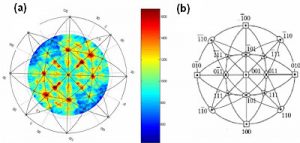X-ray Photoelectron Diffraction is one surface technique used to study the surface structure of sample. The intensity of excited photoelectron as a function of azimuthal or polar angle of sample is recorded by changing the sample position. XPD provides information on surface relaxation and also the local atomic structure down to the monolayer. Quantitative information is given combined with the electron scattering simulation. Besides, XPD is also the basis of the photoelectron holography.
This is an example of using XPD to study the surface structure of perovskite oxide (SrTiO3). Fig (a) shows the experimental Sr 3d5/2 photoelectron intensity map; (b) shows the location of high-density crystal axes and planes in the projection of figure (a).
Photodiffraction (XPD) :
Un bon moyen pour étudier la structure de la surface d'un échantillon, est d'analyser la diffraction de photoélectrons induits par des rayons X (X-ray Photoelectron Diffraction : XPD).
Par une rotation de l'échantillon, l'intensité des photoélectrons émis est enregistrée en fonction de l'angle azimutal ou polaire par rapport à la normale de l'échantillon. L'XPD fournit ainsi des informations fines sur les relaxations de surface ou encore la structure atomique locale de surface, ou des dépôts en couche mince jusqu'à l'épaisseur ultime de la monocouche. Une information quantitative peut être obtenue par simulation de la diffusion (multiple) des électrons.
L'XPD est aussi la technique de base pour les techniques d'holographie de photoélectrons.





